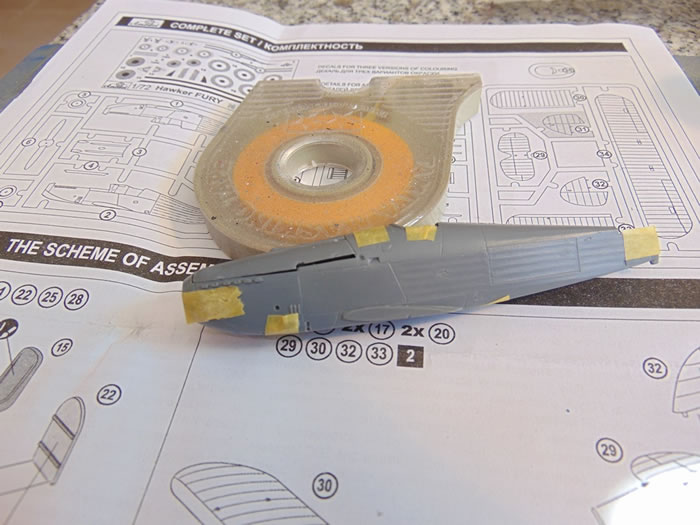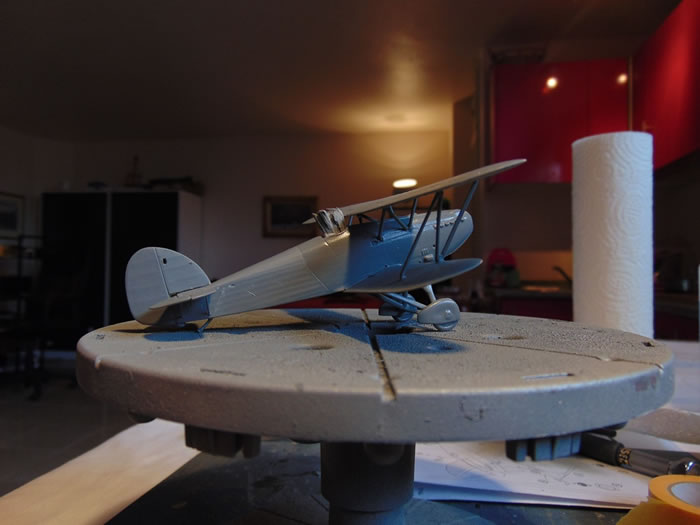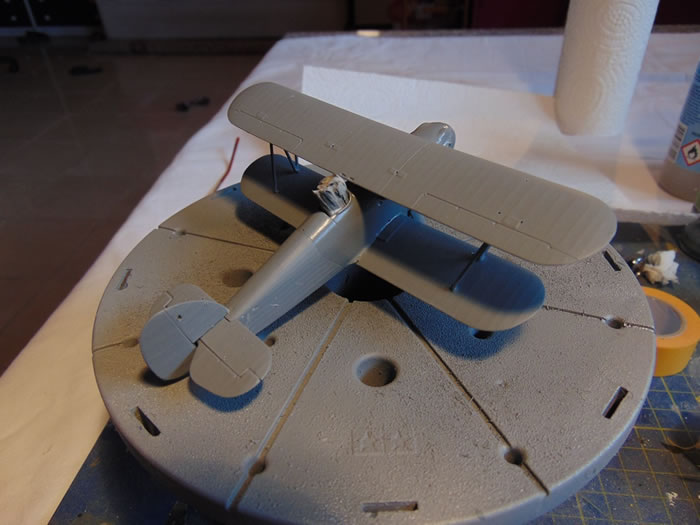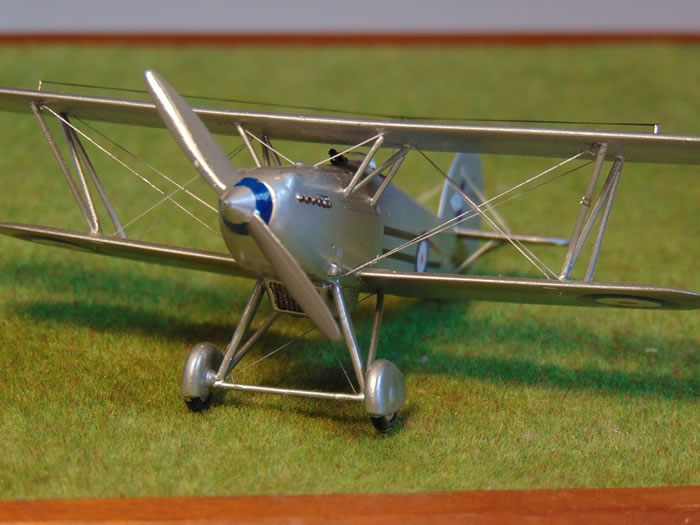A Model 1/72 scale
Hawker Fury I/II
by Roger Hardy
 |
Hawker Fury I/II |

Hasegawa's 1/72 scale B-47E Stratojet is available online from Squadron
S
u m m a r y |
| Catalogue Number: |
A Model Kit No. 72138 - Hawker Fury I/II |
| Scale: |
1/72 |
| Contents and Media: |
Injection moulded. Three sprues of 34 light grey plastic parts; one sprue of 1 clear part; markings for three aircraft. |
| Price: |
£9.40 plus shipping from Hannants
and specialist hobby retailers worldwide |
| Review Type: |
Full build review straight-from-the-box. |
| Advantages: |
Subtle surface detail. Accurate, looks nice and delicate. |
| Disadvantages: |
The wings don’t self-jig easily, poor fit of engine cover, sink marks on the wheel spats, “modelling skills are required”. |
| Conclusion: |
A sweet model. In my view, this kit is a significant improvement over the only other 1/72 Fury available so I’d recommend it, but with reservations. |
Background
 (see http://en.wikipedia.org/wiki/Hawker_Fury) (see http://en.wikipedia.org/wiki/Hawker_Fury)
The Hawker Fury was a British biplane fighter aircraft used by the Royal Air Force in the 1930s. It was a fast, agile aircraft, and holds the distinction of being the first interceptor in RAF service to capable of more than 200 MPH. The Fury is the fighter counterpart to the Hawker Hart light bomber. It had highly sensitive controls which gave it superb aerobatic performance; it was powered by a 525 hp/391 kW Kestrel engine. It was designed partly for the fast interception of bombers and to that end it had a climb rate of almost 2,400 ft/min which was pretty good for its day.
The Fury I entered squadron service with the RAF in May 1931, re-equipping No. 43 Squadron. Owing to financial limitations created by the Great Depression, only relatively small numbers of Fury Is were ordered, the type equipping only two more squadrons, 1 and 25 Squadrons. At the same time, the slower Bristol Bulldog equipped ten fighter squadrons. The Fury II entered service in 1936-1937, increasing total number of squadrons to six. Furies remained with the RAF Fighter Command until January 1939, replaced primarily with Gloster Gladiators and other types, such as Hawker Hurricane. After their front line service ended, they continued to be used for training purposes.
The Fury was exported to several customers. Three Furies were ordered by Spain in 1935, it being intended to produce another 50 under licence. The Spanish variant had a cantilever undercarriage design with Dowty internally sprung wheels, similar to that used on the Gladiator, and was powered by a 612 hp (457 kW) Hispano-Suiza 12Xbr engine, reaching a speed 234 mph (377 km/h).
A total of 262 Furies were produced, of which 22 served in Persia, 3 in Portugal, at least 30 in South Africa, 3 in Spain, at least 30 in Yugoslavia, and the remainder in the United Kingdom.
There is one surviving Fury that has been restored to flying condition. Hawker Fury Mk I, serial number K5674 , is owned by the Historical Aircraft Collection and based at the Imperial War Museum Duxford in the United Kingdom. It made its first post-restoration flight in July 2012.
The Kit
The Fury has not been well served in 1/72 scale, there being only the Matchbox/Revell offering which was actually quite a nice model compared to most of the cruder offerings from Matchbox at the time. However, it suffered from overdone rib details and needed a bit of work to make it look realistic. This offering by Polish company Amodel is far better in this respect and offers surface detailing that looks more appropriate for this sleek little fighter plus the wing trailing edges are really thin. Nice.

Moulded in soft, dark grey plastic, it is a limited run kit with good moulding quality and small moulding gates but there is a little flash here and there and most parts need tidying up. The only other moulding problem I noted were sink marks on the wheel spats (for the Mk II) where the plastic is quite thick and these will need attention as they are very noticeable and I planned to use them for a nice shiny pre-war example from No 25 Squadron (they are not used by the other marking options). The decal sheet covers three representative aircraft:
-
Hawker Fury Mk II K7264 of 25 squadron 1936/37 (silver)
-
Hawker Fury Mk I, no serial, 43 squadron, 1938 (camouflaged, black-and white underside)
-
Hawker Fury Mk I, N/218, No 1 squadron, South African Air Force from 1942 (camouflaged, Sky underside)
The roundels have separate red or orange (SAAF) centres so there is no problem with registration. Amodel also offer two other issues of this kit in Spanish Civil War markings or Yugoslavian AF for those who are looking for something a little more exotic.
The cockpit is quite comprehensive, given its small size, although the seat sides are quite thick and needed thinning. The instrument panel is the correct shape and also includes the guns. There is a decal for the panel. The fuselage inner walls have stringer detail but the cockpit opening is so small that very little can be seen. Still, this is a good effort. I added a pre-painted generic Eduard RAF WWII harness. I then put the fuselage together and found that the separate upper fuselage nose section did not fit properly at the cockpit end, so it needed to be re-positioned to avoid a 0.5mm step. Then, when it was in position it was clear that it was also too wide so a bit of trimming and filling (Milliput) were required. Whilst the Milliput was still usable I filled in the sink marks on the wheel spats. Once the fuselage joints have been cleaned up and the lost detail rescribed, it’s time for the lower wings. These are intended to butt-joint to the fuselage but I don’t like these joints so drilled 1mm holes in the wing roots and fuselage and inserted brass rod to make a better joint, also making sure that the correct dihedral is built in; the lower wing has dihedral, the upper wing does not.

The radiator under the fuselage needs a little filler at the sides and you need to refer to the colour scheme GA drawing to get the correct location; the front is between the forward undercarriage legs. I separated the elevator and rudder and re-attached them at slight angles to give a bit of life to the model. Note that the fin rests on top of the tailplane and there should be a gap between the taiplane and fuselage at the rear end and you can achieve this by removing the front tailplane locating pin but leaving the rear one. The instructions are incorrect for the tailplane struts, Part No 20 (long) should be rear and 17 (short) forward, although 17 is too short. I replaced them all with 0.5mm diameter plastic rod in any case. You need to drill holes (~0.7mm) for the other struts and undercarriage. In drilling the holes in the fuselage for the cabane struts I managed to dislodge the Milliput filler from the cowling so had to redo it with superglue. This process was helped by swearing a lot. With hindsight, because there is a large unsupported length of filler required here, it might be better to fill the gap with plastic card or something else that bonds better with plastic.

I glued the interplane and cabane struts in position but, when I came to fit the upper wing, I found that the cabane N-struts were not quite in the correct position (probably my fault), so I cut away the diagonals to allow them to fit. I added new diagonals from plastic rod later. The struts themselves are tricky to clean up but they are of scale thickness and the plastic is not brittle so there were no breakages, unlike the new Airfix Tiger Moth. You’d think that positioning 4 N-struts would be easy as the orientation is already fixed but I always seem to have a problem with it. You need to get all four to align perfectly and with limited run models this can be very tricky as you have to trim the length of the pins at the ends very precisely; if you’re 0.5mm out on any one of the struts, you have a problem as the error is magnified. To be honest, when I’d fixed the upper wing I saw that it was slightly twisted and in correcting it I decided to remove the forward interplane strut on one side and replaced it with shaped plastic rod of the correct length to get the wings to align correctly, then added the new cabane strut diagonals.

I painted the propeller spinner blue & silver and the blades grey front and black rear as I think these colours were used later in the Fury’s career. I’m not sure whether it should have yellow tips, though. The prop can be popped in at the end as long as you don’t mind it falling out occasionally. If you want it to be properly retained you need to insert the assembly when the fuselage sides are brought together.
I assembled the entire aircraft before painting because I expected problems (and got them) but at least I could then clean up the glue mess before priming. The Matchbox/Revell way of easy assembly this is much easier as it was, if I recall correctly, more-or-less self-jigging. Anyway, on a positive note, at this stage, when all cleaned up, the model is starting to look rather fine and delicate.
Rigging, Painting, Colours and Markings |
I use the Aztek A470 air brush at 15-20psi with turquoise 0.5mm high flow nozzle. If you’ve raised your eyebrows, I never try to do fancy things with an airbrush (any subtle effects I do with masking) so I choose the larger nozzle simply because it’s easier to keep clean. To this end, before putting the airbrush away when a model is finished, I use ethyl alcohol from the Chemist (ispropanol or surgical spirit) and shake the nozzles about in an old paint jar for a few minutes, then let them soak in hot soapy water before drying them. You must not leave the nozzles in the alcohol as it damages the seals and makes them useless.
I tried to do a highly polished silver example, so the colour scheme was to be very easy: Alclad White Aluminium for the fabric-covered areas and the metal panels all nice and shiny, polished to perfection. To recap, with the Alclad II highly reflective finishes (chrome, polished metal, etc) the degree of shine depends totally on the primer underneath. If it’s gloss black, then you get maximum shine whereas matt grey results in a normal unpolished metal finish. Therefore different shades of grey and different sheens will give the effect of different panel textures even though the top coat is the same paint overall; I decided to use Alclad’s ‘Chrome’ colour over gloss medium grey as I have had success with it before. Instead of actually using 50 shades of grey, I used only the Alclad grey primer but sprayed the metal panels with Alclad Gloss to get a nice backdrop for the metallic coat of paint.

After spraying the primer, I checked for defects and corrected them. I then drilled the 0.5mm holes for the rigging wire (I used EZ-line Fine). These were holes right through the wing as I did not intend to use turnbuckles or anything fancy like that as a dab of paint tends to be sufficient at 1/72 scale. I reckoned I could repair the surfaces as necessary after rigging. For the purist: the Fury has double flying wires at the front but only single at the back. The tailplane also has rigging to the fin – check references. I then masked the fabric areas to spray Alclad Klear Kote Gloss over the metal areas. Once the masking was removed, I rigged the aircraft thinking that it would be better to do it before the silver goes on as I could tidy up any blemished or glue marks which would be difficult to deal with after the metal coat is applied. I used Bob’s Buckles eyelets for the fuselage anchor points.
The entire model was then sprayed with Alclad Chrome. When that was dry, I sprayed over the wings with Alclad White Aluminium being careful to shield the highly polished areas from overspray. I was disappointed with the overall result because I sprayed it when the weather here was humid and I think this affected the chrome because the finish was cloudy and blotchy. I may have forgotten to set the minimum flow rate using the tumbler on top of the spray gun, resulting in too much paint. Anyway, the white aluminium worked nicely so I decided to apply it overall. I was disappointed with the failure of the highly polished effect as the technique has always worked in the past but I guess the moral here is: ALWAYS DO A TEST PIECE FIRST!! Actually, the white aluminium finish actually looks really good, so I’m not quite so disappointed; it’s just not what I’d intended.
The decals are matt and quite brittle so care is needed and you need to keep them verywet. I didn’t use any setting solutions. The shorter bar of the upper wing 25 sqn squadron markings is too long so it’s best to put these on first then add the roundels on top of them. The remainder of the decals are fine but need a little sheen to kill the matt for which I used Alclad’s Klear Kote Gloss when the model was finished.
I added the aerial masts (0.5mm brass rod) and aerial but in retrospect, the aerial wire is a little thick and finer line would have looked better. On reflection, my attempts to fill the sink marks in the wheel spats was spectacularly unsuccessful but you don’t need to use them as they were quickly discarded in service because they just got clogged with mud on the grass airfields. Finally I added the pitot-static head on the port wing strut; this is not provided in the kit and I used some scrap p/e from my spares box.
Anyway, it’s done. I’m amazed by how small it is; about the same size as a Tiger Moth (but with five times the power) and much smaller than the Hurricane. Really sweet!
I haven’t compared this model to drawings because I don’t trust drawings, but it looks exactly right to me. Sitting next to the 1/32 Alley Cat Fury, it looks identical so I’d say is was accurate. The assembly could have been easier but this is a limited run model and most of the problems were probably caused by me. Overall, it looks nice and delicate, the surface detail is correct and not overdone so, even at 1/72 scale it looks right; there is nothing that looks clumpy or out-of-scale. In my view, this model is a significant improvement over the only other 1/72 Fury available so I’d recommend it, even if you need to approach it with more care and patience.
Model, Images and Text
Copyright ©
2015 by Roger Hardy
Page Created 6 April, 2015
Last Updated
6 April, 2015
Back to HyperScale Main Page
|
Home
| What's New | Features | Gallery | Reviews | Reference | Resource Guides | Forum |